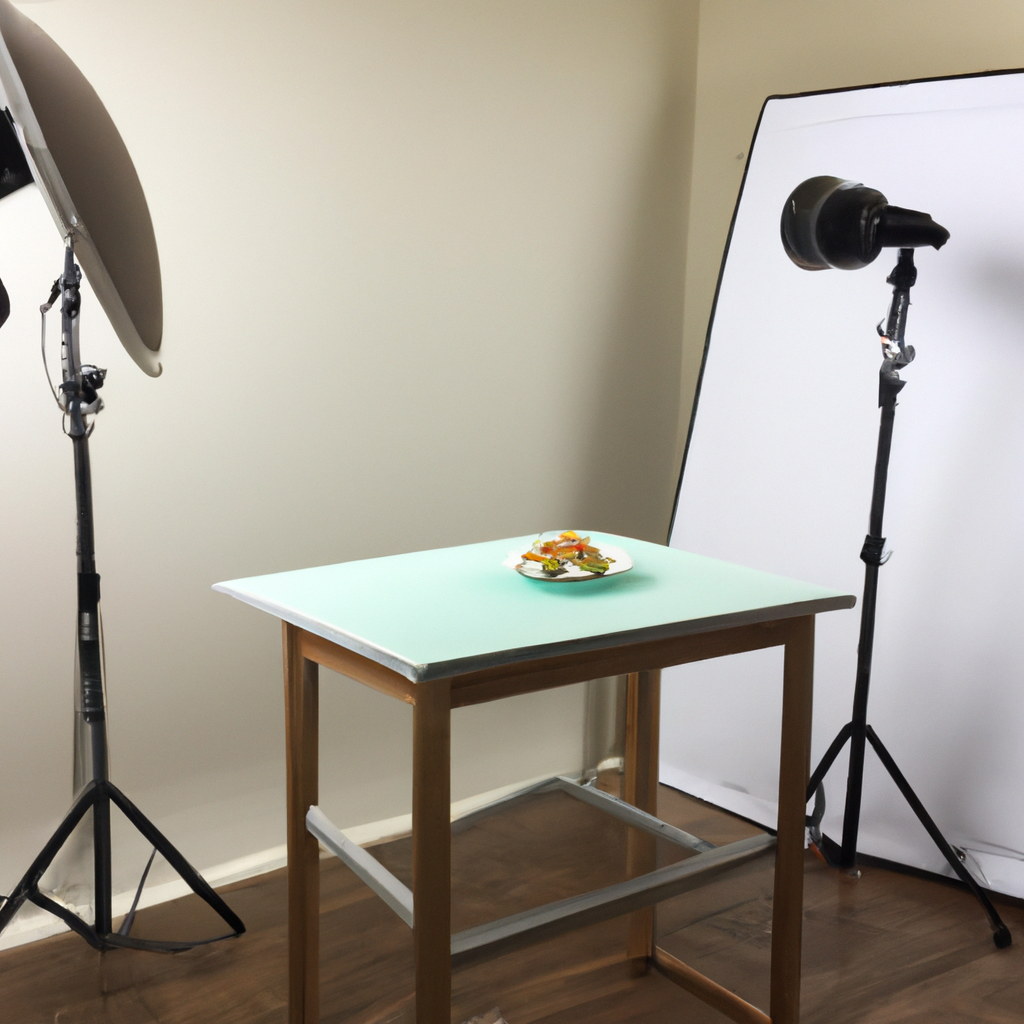Unlock the doors to the delicious world of food photography as we take you behind the scenes of setting up your very own culinary dreamland. Step into a realm where artistry meets appetite, where fragrant aromas dance with vibrant colors, and where the ordinary is transformed into a delectable masterpiece through the lens of a camera. From the arrangement of props to the careful manipulation of lighting, this article unveils the secrets of crafting your very own food photography studio. So, roll up your sleeves, sharpen your senses, and prepare to embark on a mouthwatering journey through the intricate process of capturing food in all its mouthwatering glory.
1. Unveiling the Secrets of Food Photography: Step-by-Step Guide to Creating Your Dream Studio
Food photography is an art that requires careful attention to detail and creativity. Capturing the perfect shot of a delicious meal can make mouths water and entice people to try the dish for themselves. But, have you ever wondered how photographers achieve those stunning images? In this step-by-step guide, we will unveil the secrets of food photography and help you create your dream studio to take your culinary images to the next level.
Gather the Essential Equipment
Before diving into the world of food photography, it’s important to gather the necessary equipment to set up your dream studio. Here are some essential items to consider:
- A high-quality DSLR camera or mirrorless camera
- A variety of lenses for different types of shots
- A sturdy tripod for stability
- Artificial lighting options, like softboxes or LED panels
- A selection of props to enhance the composition of your photos
Create the Perfect Setting
Creating an inviting and visually appealing setting is crucial in food photography. Consider these steps to create a dream studio:
- Choose a dedicated space with ample natural light or create your own with artificial lighting.
- Set up a table with a neutral-colored background to make your dishes stand out.
- Experiment with different textures and surfaces for your table, such as wooden boards or marble slabs.
- Arrange props strategically to add interest and tell a story through your images.
- Don’t forget about the importance of colors and coordination. Choose plates, cutlery, and cloth napkins that complement your food and enhance the overall aesthetic.
Mastering the Art of Styling
Styling is a key element in food photography that allows you to elevate your images from ordinary to extraordinary. Here are some tips to help you master the art of styling:
- Focus on the main dish and create an attractive focal point.
- Consider adding garnishes and ingredients that enhance the composition and add visual interest.
- Play with different angles to capture the best perspective of your food.
- Experiment with props to add depth and context, such as fresh herbs, utensils, or unique serving dishes.
- Pay attention to details like cleaning up any spills or imperfections before shooting.
2. Igniting Culinary Artistry: Behind-the-Scenes Insights into Crafting the Perfect Food Photography Studio
When it comes to food photography, creating a perfect studio is crucial to capturing mouthwatering images that entice and inspire viewers. Behind-the-scenes, there is a delicate art to crafting the ideal space where culinary masterpieces can be beautifully showcased. From the lighting to the props, every element plays a significant role in bringing out the best in the food.
Lighting: Illumination is the key to showcasing the colors and textures of the dishes in all their glory. A good studio setup includes a variety of lighting options, such as natural light, artificial overhead lights, and diffused light sources. This allows photographers to adjust the intensity and direction of light, creating depth and highlighting specific areas of the food.
Props and Background: Selecting the right props and background is crucial in creating a visually pleasing aesthetic. It’s essential to strike a balance between enhancing the appeal of the food without overpowering it. A collection of plates, utensils, and decorative elements can add interest and create a story around the dish being photographed. The choice of background, whether it’s a rustic wooden table or a clean, minimalist surface, sets the tone and can make the food stand out.
Composition and Styling: In food photography, composition and styling go hand in hand to create a visually appealing image. The arrangement of the food on the plate, the use of negative space, and the angles from which the dish is photographed all contribute to the overall composition. Styling techniques, such as adding garnishes or applying a glaze, elevate the visual appeal and make the dish look even more enticing.
Editing and Post-Processing: Once the perfect shot is captured, editing and post-processing bring the image to life. Enhancements like adjusting exposure, white balance, and saturation can make the colors pop and highlight the intricate details of the food. Additionally, retouching any imperfections or distractions ensures a flawless final image, enticing viewers to indulge in the culinary masterpiece.
In conclusion, crafting the perfect food photography studio requires meticulous attention to detail in lighting, prop selection, composition, and post-processing. By combining these elements, photographers can capture the essence and beauty of gastronomy, enticing a craving that only culinary artistry can satisfy.
3. A Peek into the Captivating World of Food Photography: Unraveling the Mysteries of Setting Up a Dreamy Studio
Food photography is a mesmerizing art form that allows us to capture the beauty and essence of delicious dishes. Behind every stunning food photograph lies a meticulously set up studio, where magical moments are captured on camera. In this section, we will peel back the curtain and reveal the secrets to creating a dreamy food photography studio that will leave you awe-inspired.
Lighting is the fundamental key to achieving captivating food photographs. Start by utilizing natural light as much as possible. Set up your studio near a large window that allows soft, diffused light to flood the scene. If natural light is limited, invest in a few high-quality, adjustable studio lights to recreate that soft glow.
Creating an inviting atmosphere is crucial for food photography. Choose a color scheme that complements the style of your dishes, whether it’s rustic and earthy tones or vibrant and bold hues. Incorporate props like vintage plates, linen napkins, and fresh flowers to add a touch of elegance and depth to your compositions.
A well-designed backdrop can make or break a food photograph. Consider using various materials such as marble, reclaimed wood, or textured wallpapers to add visual interest and depth to your shots. Experiment with different textures and patterns to create unique and eye-catching compositions.
- Invest in a sturdy tripod to ensure crisp and sharp images, especially when using slower shutter speeds.
- Utilize different angles and perspectives to showcase the food in the most appetizing way.
- Experiment with depth of field to highlight specific elements and create a dreamy, blurred background.
- Don’t be afraid to use props strategically to enhance the story and mood of your food photographs.
Keep in mind that the process of setting up a dreamy food photography studio is a continuous learning experience. Experiment, play with different techniques, and let your creativity run wild. With patience and practice, you’ll unlock the mysteries of food photography and create stunning images that make mouths water and captivate audiences around the world.
4. Elevate Your Food Photography Game: Dive into the Intricate Process of Designing a Picture-Perfect Studio
When it comes to food photography, a stunning photo can make all the difference in capturing the essence of a dish. Dive into the intricate process of designing a picture-perfect studio to take your food photography game to the next level.
1. Set the Mood: Lighting is crucial in creating captivating food photos. Invest in soft, diffused lighting options such as a lightbox or softboxes to minimize harsh shadows and create a warm ambiance. Experiment with different lighting angles to highlight key elements of the dish.
2. Tidy Up: A clutter-free studio is vital to draw the focus on the main subject, your mouth-watering creations. Organize your props, utensils, and backgrounds neatly, ensuring they complement the dish without overpowering it. Keep a variety of neutral colored backgrounds and textures handy for versatility.
3. Props and Styling: Selecting the right props is crucial in enhancing the story behind the food. Opt for props that reflect the mood and style you want to convey. Experiment with different textures, colors, and arrangements to create visually appealing compositions that make the food pop.
4. Perfect Plating: Pay meticulous attention to how you plate the dish. Experiment with different plating techniques to create stunning visual effects and draw the viewer’s eye to the most appetizing elements. Use garnishes strategically to add an extra layer of intrigue to the photo.
5. Composition and Angles: Experiment with various compositions and angles to find the most captivating shot. Consider utilizing the rule of thirds for a balanced composition or try shooting from different heights and perspectives to add depth and visual interest.
6. Post-Processing Magic: Once you have captured the perfect shot, polish it further with post-processing software. Adjust the exposure, contrast, and colors to enhance the overall look of the image. Remember to maintain a natural and realistic feel, allowing the food to remain the star of the show.
By immersing yourself in the intricate process of designing a picture-perfect studio, you’ll elevate your food photography game to new heights. So unleash your creativity, experiment with various elements, and embrace the art of telling a delicious story through your lens.
Setting up your own food photography studio doesn’t have to be hard! With the right tools, planning, and attitude, it’s easy to have a fun and successful photoshoot. Now it’s time to capture some beautiful images of all your delicious dishes! Bon appetit!



